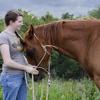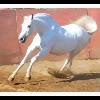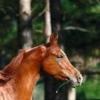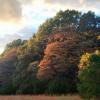Some wild horse coat colors
Forums
Yes some of those wild horses
Yes some of those wild horses in particular ( from dry and cold periods, with open environment ( steppes), were bay dun with pangare), I think that´s the most logical explanation. But unlike the modern known appearance of Przewalski, there was a clear profusion of zebra striping in late Pleistocene wild horses from certain regions.
Many thanks for your opinion!
Just as curiosity, here it´s this zebra striped back horse history:
«his mother (name is 'sable') is a mustang from the northern calif area and was caught out of "devil garden"..(i have her also) she herself is solid black (but obviously carrys the gene) when i adopted her from the BLM,, there were many black horses there, no buckskin or dun.. when she trots her front legs "paddle out" very similar to a paso, and is very smooth ride,, sable has had 3 foals, 2 black fillies (one from an appaloosa,, one from a MFT) and the colt is 'awesome'
awesomes father was a buckskin quarterhorse, and has never thrown a color like awesome..
awesomes color is not bay but rather "smutty dun" or some people call him a "RED grulla"... the buckskin association took a whole year trying to decide what color he was and they never told me for sure, so the registered him as a 'dun'.. i think the only way to know for sure is to do some DNA testing..
in the winter he is more red and in the summer he is more golden,, i have owned horses my whole life and i have never seen another one like him.»
I'm not sure about Awesome,
I'm not sure about Awesome, but the last picture just looks like heavy shoulder barring to me? I don't see any stripes other than what would be associated with dun factor in the cave paintings. I would love to see some color testing on Awesome...neat marking. I don't see sooty buckskin at all...MAYBE smokey brown. Can we see photos of the parents?
HiI can show already how the
Hi
I can show already how the mother of «Awesome» looks like.
See attachment. By the way, she´s described on information given about «Awesome» above.
I hope to post pictures about the father ( but you can already read the description).
More data about them will be posted.
Yeah, not so sure about that
Yeah, not so sure about that horse with dark bars on the neck, hence my question about him. And thanks for your explanation.
But, I´m not only questioning that horse coloration, but also the other ones. Some incredibly fit on many details from the cave paintings ( some paintings actually were done in Iberia, from where these horses did came from originally).
I´m not trying to make a point about them being wild horses ( actually being related with wild horses is much more than just simply having primitive coat coloration). But actually some of them ( very, very few) retain some other wild horse features as well ( not only coloration) so that may be result of «something» from wild horses. Though that won´t be mentioned here, because it´s not the right place.
I´m also curious about native american wild horses coloration. Hopefully will post something about it, later. Fortunately there´s even an hide, to talk about!
TSH, Basically from the
TSH, Basically from the research I've done, every zebra hybrid, with the exception of a handfull, are all bay, some are wild bay, some regular and some are brown based. The handfull that are super dark could be argued to be just dark brown, like some At horses that appear black. I have never come across an adult zebra hybrid that is chestnut, and every foal that is claimed to be chestnut darken up to be wild or regular bay. This supports my theory that zebras are homozygous black, and homozygous bay as well, and of course dun, so EE A?A? DD. The other supporting evidence I had was from the zebras from the Quagga Project, they are selectively breeding them for more body color and less stripes, and they are starting to look like Quaggas.
Okay, so I have categorized
Okay, so I have categorized zebra hybrids into 3 bay categories based on shade, stripe color and point height. I'm sure my categories may not be completely correct, as I couldn't decide to judge wild bay based on points or body shade or both, so that category is kinda iffy. I was trying to judge more off of how we would categorize horses, so the donkey ones are not quite right as donkeys are a lot harder to tell body shades and points with so much pangare.
Bay
Zorses
http://lovelifelikeyourself.files.wordp…
http://www.namaquahorsetrails.co.za/Zor…
http://fc06.deviantart.net/fs51/i/2009/…
Zonkeys
http://1.bp.blogspot.com/-bdZ-hugA4HU/T…
http://4.bp.blogspot.com/_-dxg8gReUqE/S…
With donkey spotting http://jmdecker.files.wordpress.com/201…
This guy has donkey spotting, but a very unusual head marking for it http://geneticsandliterature.files.word…
Wild Bay
Zorses
http://animaltales.info/files/2010/11/3…
http://k43.pbase.com/o6/48/726648/1/845… http://i.pbase.com/o6/48/726648/1/84669…
This one is half belgian and half grevys zebra, and she is huge http://horseandman.com/wp-content/uploa…
http://i78.photobucket.com/albums/j103/…
Zonkeys
http://4.bp.blogspot.com/-eeXCxR-gmyw/T…
http://impressivemagazine.com/wp-conten…
http://farm5.static.flickr.com/4108/483…
Dark bay/Brown
Zorses
http://lovelifelikeyourself.files.wordp…
http://fast1.onesite.com/community.outd…
http://fc00.deviantart.net/fs49/i/2009/…
http://4.bp.blogspot.com/_a-gSFjRjw30/T…
Zonkeys
http://www.flatrock.org.nz/static/front…
http://a-z-animals.com/media/animals/im…
http://www.freewebs.com/draagonfliir/An…
http://img1.photographersdirect.com/img…
http://www.lensmeyoureye.com/wp-content…
Nifty other tidbits,
Greying Zorse, 5yo in this picture, Grants sire and grey arab dam
http://4.bp.blogspot.com/-bbh5xxju-3Y/T…
http://www.zeldathezorse.com/index.html
This zonkey looks to be roan as well
http://s0.geograph.org.uk/geophotos/01/…
The other part of this is the zebras with shadow stripes and the Quagga Project, all the project did was take zebras that had a lot of shadow striping and cross them to start to reduce the amount of striping they had. You can really see how red they get when the striping is reduced.
Shadow stripes
http://media.capetowndailyphoto.com/wp-…
http://joetourist.ca/botswana/images/20…
http://cdn.c.photoshelter.com/img-get/I…
http://www.madamzebra.com/images/Chapma…
Burchells Zebra http://1.bp.blogspot.com/--MTnScFm28I/T…
No shadow stripes but very red faced http://1.bp.blogspot.com/-TuGu27KTJuE/T…
http://cdn1.arkive.org/media/49/49202F0…
http://www.esafaris.co.za/fauna/mountai…
Zebra foals are also very red, similar to a bay horse foal or a bay donkey
http://cdn1.arkive.org/media/21/2177A3D…
http://cdn2.arkive.org/media/F4/F4BB58B…
http://static.zsl.org/images/width400/z…
http://ic2.pbase.com/g4/26/576926/2/520…
http://www.africadreamsafaris.com/blog/…
Quagga project http://www.quaggaproject.org/
http://4.bp.blogspot.com/--ZLWAYWb-KY/T…
http://i.ytimg.com/vi/mVDncjzpNJI/0.jpg
http://www.timeslive.co.za/Feeds/2012/0…
«A partial carcass of a small
«A partial carcass of a small extinct Yukon horse was found by placer miners Lee Olynyk and Ron Toews in September 1993 on Last Chance Creek near Dawson City. It is the best preserved carcass of one of the larger Ice Age mammals found in Canada. Most of the right foreleg with dried flesh, skin and hair on the lower parts, and a large part of the hide with long blondish mane, were found intact. Studies to date show that the horse was a large adult, and that its hair ranged from blackish-brown above the hoof, through chestnut, to blondish on the mane. The hide is currently at the Canadian Conservation Institute in Ottawa being stabilized. Recent analysis of bone submitted for radiocarbon dating indicates that the horse died about 26,000 years ago during a relatively warm period before the peak of the last glaciation. Preserved DNA from the horse carcass demonstrates that the Yukon wild horse is closely related to the modern horse. These horses roamed in large herds across the steppe-like grasslands of northwestern North America during the last half of the Ice Age. The species died out about 10,000 years ago. With this find our knowledge of the species increased greatly and another piece of the Beringian puzzle fit together.»
I would really love for
I would really love for someone to point out where I'm wrong, but it just seems like there is a lot of information supporting my idea. I know when I get a zebra, I am definitely going to do some test breedings, and I really would want the first to be a (gaited) chestnut, no agouti stallion, just to see what type of bay foal you get.
Very interesting that
Very interesting informations, CMhorses!
Now, maybe some of you already know this, but I´ll put here anyway:






I think they were most likely
I think they were most likely bay dun with pangare. If you look at wild equines, all the ones I can think of can be pretty easily argued that they are bay dun with pangare. Just look at wild asses, Przewalski's and zebras for example.